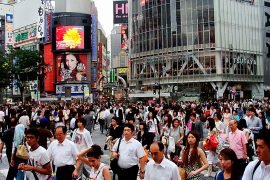[highlight]Leia em Português[/highlight]
Kyoto has an infinity of temples, pavilions, gardens, palaces and thermae. It is best to get organized and make a “to do list” about what you would like to see. Reminder: Kyoto is quite big and it takes time to go from one place to another, and most attractions close around 5pm.

THE TEMPLE OF THE GOLDEN PAVILION (KINKAKU-JI) – It is the main touristic place. It dates to the 14th century and was dedicated to the memory of Shogun Ashikaga Yoshimitsu. The original temple burned down in 1950, the current one is a replica. It is not famous just because the top two floors are covered with gold leaf, but also because we have the impression it floats on water.
TEMPLE OF THE SILVER PAVILION (GINKAKU-JI) – A bit less famous than the Golden Pavilion, even because it started being built in the 15th century by Shogun Ashikaga Yoshimasa and was never finished. It was supposed to have silver-foil overlay, but that never happened either. The most beautiful thing is its zen garden, with moss and stones. From the surrounding path you can have quite a good view of the place.

TÔ-JI BUDDHIST TEMPLE – This one is well-known for its five-storey pagoda (55m high), the tallest and most famous wooden tower in Japan. It is pretty near the train station, it is worth the visit.
RYÔAN-JI – The most perfect zen garden ever (according to the brochure we got there). Made of raked gravel and fifteen moss-covered boulders, it was designed in 1455 and evokes the sea waves around 15 islands (represented by the boulders). However, the islands cannot be seen at once; you need to look at different angles to know them all (a metaphor about how complex truth is). The paintings on the fusumas are very unique, a “must see”.

NIJÔ-JO (SHOGUN PALACE) – It is the house/fortress of Tokugawa Shoguns (warlords from the 1600). Spectacular construction, there are sliding doors (shojis) in the rooms and rich paintings on the walls. The garden is breathtaking.

THERMAE (ONSEN) – Thermae baths are part of the Japanese ancient culture and are still popular nowadays (quite a compulsory activity among the Japanese I met). The most famous thermaes are in Tokyo and Kyoto, and many hotels offer this service.

THE DISTRICT OF GION – Home to many geishas and tea houses. If you are willing to be part of it, you should schedule in advance. On the main street, there are all kinds of stores, even though the entrance makes them all look alike.
Translated by Lúcia Maciel
English teacher
Contact: luciamaciel@territorios.com.br
© All rights reserved. Pictures and report 100% originals.









